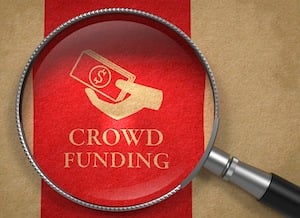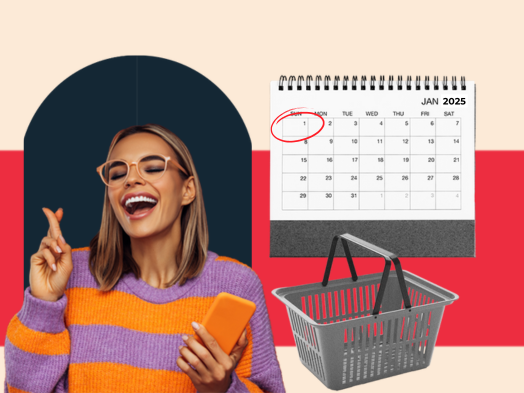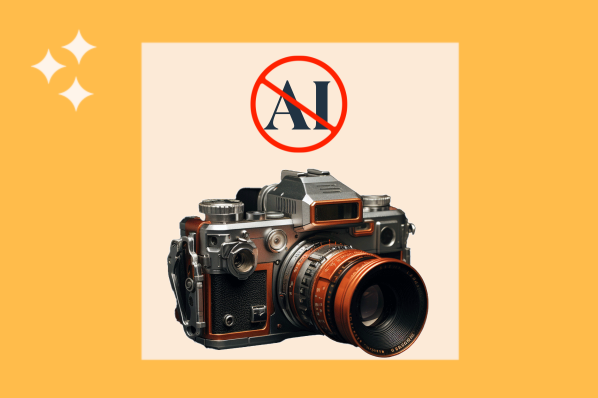 In 2013, 3 million people from 214 countries and territories (and all seven continents) pledged $480 million to Kickstarter projects. From Cards Against Humanity, to Pebble smartwatches, to a human-powered helicopter, Kickstarter changed the world and lives of hundreds of thousands of small business owners and entrepreneurs through its crowdfunding platform.
In 2013, 3 million people from 214 countries and territories (and all seven continents) pledged $480 million to Kickstarter projects. From Cards Against Humanity, to Pebble smartwatches, to a human-powered helicopter, Kickstarter changed the world and lives of hundreds of thousands of small business owners and entrepreneurs through its crowdfunding platform.
But we want to focus on this year, and, specifically, one project that has started and been fully funded in less than one month through the crowdfunding site. The two people behind this project were kind enough to share their campaign journey with us.
We interviewed first-time Kickstarters Kirsten and John Newbold-Knipp about their campaign for RingSafe, a modern clasp designed to prevent losing your wedding ring. We discovered how they succeeded in fully funding their campaign in just 30 days, exceeding their goal of $15,000 with a few days left to fundraise.
Check out the interview below, and learn how you can apply some of their campaign tactics and tips to your own crowdfunding campaign.
Q: Why did you create RingSafe?
A: We invented RingSafe because John misplaced his ring just a few days after our honeymoon, and after talking to others, we realized it's a really common problem. Our survey shows that 4 in 10 men lose their ring at some point, and online data suggests 30-40% of all married people lose rings at work, at sport, or around the house.
Q: Why did you decide to use Kickstarter?
A: We had gotten lots of positive feedback about the concept of RingSafe from friends and family, but wanted to know whether the broader world would find it valuable. While we could have funded production ourselves, there was a risk that we were just dropping in money without certainty that there is a real market and without enough feedback to make the product appealing. Kickstarter was a way to combine test marketing with market feedback and reduce the risk of funding ourselves.
We have seen some amazing ideas come out of the Kickstarter community and thought this was the optimal avenue to try it ourselves. Getting some early press and publicity via Kickstarter before we launched fully online is something we think will be helpful for the product in the long term.
Q: How long did it take you to set up your campaign?
A: The actual set-up is quite fast, if you are disciplined in your approach. Our ideation phase was 3-4 months, and then the real ramp-up to our campaign was only about six weeks. But, we should have done more prep in advance to make it an even greater success.
Here's a timeline of our relatively rapid campaign approach:
- July 5, 2013: We got married!
- July 26, 2013: Three days post-honeymoon, John's ring is misplaced.
- August 2013: The idea was born, as we played with different ways to secure John's ring that were fast and easy to use.
- September-November 2013: We made 5-10 plastic 3D printed prototypes on John's 3D printer. Feedback from friends and some more brainstorming led to the first metal prototypes. During this time, we started thinking Kickstarter could be a great avenue to go to market.
- November 2013: We decided we wanted to do this as a Kickstarter campaign and began to build our plan between 80-hour workweeks at our day jobs.
- December 2013: We got really busy! Facebook, Twitter, and LinkedIn profiles were created. Our Kickstarter how-to blog posts and books were ravenously consumed. We commissioned our logo using 99designs and a freelancer (our freelancer's design won), did a video and photo shoot, conducted surveys and test marketing on Facebook, and began concepting of our Kickstarter campaign reward levels.
- Early January 2014: It went down to the wire. Our original plan was to go live on Friday, January 3, because we wanted the most weekends possible in our 30-day campaign. But because we'd been busier at our day jobs than expected over the holidays, we pushed back by one week to launch on Friday, January 10. We were unsure if we'd hit our target date, so that influenced our decision to push back as well.
- January 10, 2014: We pulled an all-nighter from January 9-10 to polish up our campaign and do a first touch of outreach to a long list of influencers, friends, family, and more. We got goosebumps and were pumped that people we didn't know were giving us their vote of confidence in the form of actual orders!
- February 4, 2014: We hit our goal of $15,000 with four days to go in our pledge goal date!
Q: What channels did you use to promote your campaign? Which ones were effective?
A: We used several channels to promote the campaign.
Kickstarter Community
We've been pleasantly surprised by how engaged the Kickstarter community is -- our largest number of backers come from within the referral traffic from Kickstarter.
Blogger and Publication Outreach
This is an area to invest in early and often. We developed a list of about 50-60 publications that were targets for us and did both direct outreach as well as outreach via any LinkedIn connections we might have in common with an editor.
Developing a short, sweet pitch that is tailored by the publication and providing links and image assets to make it easy to cover your idea is important. Develop a newsworthy angle and press release for the first few days of your campaign. We weren't as confident about our 'newsworthiness' and decided to postpone a PR, which was a mistake. Even if we had gotten light pick-up, it would have contributed to the early success of the campaign.
Social Media and Blogging
We built a small social following before our campaign -- just about 200-250 folks on Facebook and Twitter combined, which has now grown to 300+. This is an area where investing further in advance would have really benefited our campaign. Some of the Kickstarters that have 'blown it out' are actually 1-to-2-year-old ideas that have built thousands of social followers before they tested the waters on Kickstarter.
Don't underestimate the reach and support of your own personal network. Both John and I created free MailChimp accounts and uploaded our contacts from across all our networks. We have tried very hard to limit email to just 1-2 touches, with one more coming at the close of the campaign, and, in each case, we've seen a nice bump either from direct backers or from our network sharing the RingSafe story with their friends.
Kickstarter Co-Marketing
We used some of the classic tenets of complementary product marketing. During our campaign, we found other projects we liked and respected that were targeting similar audiences. We backed them and then offered to share their projects with our backers and social followers if they would do the same in return. Not all said yes, but several did, and we've each shared something of value with our followers and gotten a little lift back -- we've even shared advice and tips.
Q: What did you like most about Kickstarter?
A: Kickstarter is relatively easy to set up, and the community truly is very engaged and helpful. A few things that were really pleasantly surprising:
- Kickstarter is real-time: The nature and speed of the feedback you get makes it very fun. There's a bit of gamification in watching your stats directly as well as via tools like Kicktraq.
- Kickstarter is truly global: We have backers coming in from all over the world, several of whom are hoping to help us scale the product once we go to production.
- Kickstarter is pretty darn easy to set up: The software is generally very user-friendly (with a few quirks you learn along the way).
- Kickstarter improves insight while reducing risk: Yes, you'll pay a commission to Kickstarter, but that's only if you succeed. We've studied a number of failed projects -- they fail because they were either a bad idea, badly executed, or had no following. What was in our control was our execution and following, so Kickstarter has been helping us determine if the idea is a good or bad one.
Q: If you were to run a crowdfunding campaign again, would you use Kickstarter?
A: Probably. While there are a few other crowdfunding tools out there, the learning that we got using Kickstarter and the strength of the community would make it easier for us to be successful a second time around. We did consider Indiegogo early on, but the only benefit is that they allow for partial funding. In our minds, if we didn't hit the funding goal, then we probably shouldn't proceed anyway, so the size of the Kickstarter community outweighed the Indiegogo benefit.
The pros of using Kickstarter certainly outweigh the cons.
Q: If you were helping someone run a Kickstarter campaign, what's the one or two things you would tell them to do to be successful?
A: Two things.
1) Build your community and following early.
Try to have at least 500-1,000 engaged fans before you go live. It will boost your early virality and make it so much easier to get coverage in the press and featured spots on Kickstarter.
2) Create professional assets.
All the projects that are winning have pretty slick videos and images. Those that fail are often very poorly executed. Today, it doesn't have to cost an arm and a leg to do this -- our total spend on logo, video, and images before our campaign was under $500. It's not free, but we do have some skin in the game to make this work. We even negotiated with our freelancers to give them a success reward if we are fully funded, to get them engaged with you to win.
What are your thoughts on using Kickstarter? Think your organization could benefit from utilizing it for fundraising?
Marketing Campaigns


![How to run a marketing campaign on a tight budget [expert tips & free tools]](https://53.fs1.hubspotusercontent-na1.net/hubfs/53/19_What%20is%20a%20Marketing%20Plan%20%26%20How%20to%20Write%20One%20%5B+Examples%5D.png)

![How to Create a Successful Marketing Campaign [Strategies, Data, + Examples]](https://53.fs1.hubspotusercontent-na1.net/hubfs/53/marketing-campaign.webp)
![I Took a Deep Dive Into PERT to Create More Accurate Time Estimates [+ Templates, Examples, and Formula]](https://53.fs1.hubspotusercontent-na1.net/hubfs/53/pert-1-20250213-8082845.webp)
![4 Clever Olympics Marketing Campaigns [+Top Takeaways]](https://53.fs1.hubspotusercontent-na1.net/hubfs/53/best-olympic-marketing-campaigns-1-20240809-9542066.webp)


